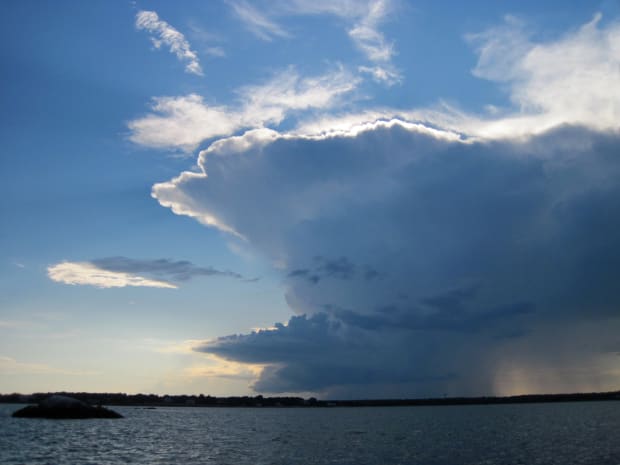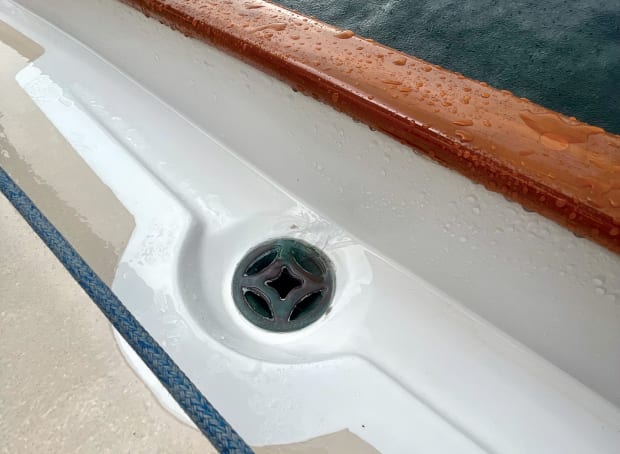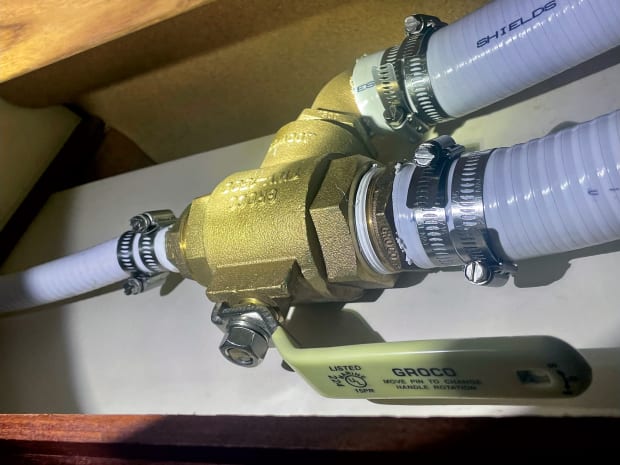
Photo by Wendy Mitman Clarke
Mother Nature is good at heavy lifting. She effortlessly—and depending on where you sail, fairly regularly—delivers thousands of gallons of precious drinking water directly to the decks of our sailboats. All that work and water needn’t go down the drain.
To harvest rain, on our 36-foot Morris Justine, Sundance, we’ve installed Y-valves in the deck scupper hoses. Most of the time, the valves are positioned to let rain, wash, and spray pass directly from deck to sea. But when we swing the valves to their catchment position, rainwater is diverted to our water tanks.
Rain catchment systems have been in use ever since the first sailboat went on a voyage. Sailors were just as thirsty then as they are now. And while a bottle o’ rum is both legendary and appealing, the smartest way to satiate a seafaring thirst has always been to catch and drink rainwater.
Even in modern times, a dock with clean hose water isn’t always conveniently available, and boat tanks can run dry before landfall at the next dock is made. The reverse osmosis watermaker is a great invention that has found a home on many boats, including ours. But these machines consume power and are prone to failure, so it’s nice to have a plan B. Rain has always been there, and a scupper drain diverter valve is a simple and effective way to catch it.
Canvas rain harvesting systems suspended in the rigging are popular in the bluewater sailing world. They are also cumbersome to set up, bulky to stow, and capture only a tiny fraction of what a deck scupper diverter catches. On boats lacking deck scuppers, a canvas system may be the only option for catchment, but if a scupper is there, it makes sense to use it.

Photo by Christopher Birch
Our Chuck Paine-designed Morris Justine has significant bulwarks and is particularly good at catching rainwater. All the rain that hits the rigging, sails, house, and deck drains off through a pair of amidships scuppers. Beneath each scupper, we’ve installed an inline Y-valve plumbed to divert water on demand to each of our two 50-gallon water tanks. We can easily start catching rainwater by turning the pair of valves from the dry comfort of our boat’s cabin. The volume of water collected is impressive. In heavy rain, we can fill both tanks in under 10 minutes.
Cleanliness of the collected water is an essential concern to address. We wash our decks frequently with dish soap instead of the more toxic boat soaps, and we clean around the diesel deck fill carefully after taking on fuel. At anchor, a thorough rain rinse before valving over to rain collection will remove all the salt and most dust and grime from the deck. Rinsing before collecting produces significantly cleaner water than a permanent household roof catchment system will produce. Underway in heavy weather, saltwater spray contamination is a deal killer and will make rain harvesting off the deck impossible. But in more settled conditions, stopping to collect rainwater can be successfully accomplished by heaving to.
We opted not to install a filter between the diverter valve and the tank for several reasons: First, a good rain rinse before switching over the valves will eliminate most of what a filter would catch. Second, an inline filter between deck and tank is prone to growth of bacteria spores when the rain catchment system is used only sporadically. Lastly, water head pressure in the catchment system may not be sufficient to penetrate a filter of any significance. If this is the case, a filter can function as a dam, blocking all water flow to the tank.
Instead of a filter before the tank, we focus on cleanliness in the tank, and filtration between the tank and the tap at the sink. For water purification, we treat tank water with AquaMega tabs every two weeks. We also make a point of emptying and cleaning the tanks through their inspection ports every six months.

Photo by Christopher Birch
For filtration between the tank and the taps, we use a carbon block Pentek Flo-Plus-10, 0.5-micron filter. The combination of chlorination and filtration effectively keep all cysts, bacteria, and viruses out of the water we drink. The carbon block filter also removes all chlorine, making our tank water safe to use for flushing our watermaker. This combination of purification and filtration is best practice for managing tank water cleanliness and should also protect us against any substandard municipal hose water loaded onboard when dockside.
Installation of the Y-valve for the catchment diversion will vary from boat to boat, and in our case from tank to tank within our one boat. The optimum location for this valve will provide easy access for the crew and reliable gravity flow in both valve positions. To ensure the deck will continue to drain quickly, it’s important not to reduce the diameter of the deck scupper hose with the diverter valve plumbing. Once diverted, the hose size can be reduced to minimize cost and allow for ease of routing to the water tank. On Sundance, the scupper hoses between deck and waterline through-hulls are 1.5 inches. The Y-valves maintain this diameter. After diversion, we reduced the hose size to ¾-inch for the run to the tanks.
Commonly available Shields Series 148 hose is FDA-approved for water tank fill and is suitable for the deck scupper hose and the division hose to the tanks. The hose run from the diverter Y-valve to the water tank should maintain a constant downward slant and avoid dips where water could collect and stagnate when the system is not in use.
Once at the tank, the diversion line deposits collected water via a simple T fitting in the tank fill hose. Double clamping all hoses is an appropriate safety measure. It is also important to mount the valve to a sturdy surface within the boat to prevent flex and chafe damage to the hoses.
Human error can cause trouble with this system. Forgetting to switch the diversion Y-valves back to the drain position after the tank is full, or the rain has stopped, will leave the water tanks open and exposed to contamination from above. On Sundance, when the valves are set to their catchment position, we tie a pink bandana to a prominent spot in the companionway to remind us of this. When the rain is pounding, and the pink bandana is flying in the cabin, we stay off the deck. The bandana, and a spare, are tied to the diverter valve handles for storage when harvesting is complete.
Cruising full-time on Sundance, we find that our DC-powered Spectra watermaker provides most of our freshwater needs. We augment the product from that machine with dock hose water and rain catchment as needed and when available. On bluewater legs of our journey, when dock hose water isn’t an option, it’s a comfort to know that should our watermaker fail, we still have a built-in plan B. The plumbing work required to adapt our scupper lines was easy, making it a no-brainer option.
A rain catchment system is to the watermaker what a self-steering windvane is to the autopilot. When things go wrong with complex, power-hungry systems offshore, it’s smart to have a simple, bulletproof backup that requires no power. Mother Nature patiently follows our slow progress across the big ocean hauling drinking water for us. All we have to do is hold out a cup to catch it.
Christopher Birch is the founder of Birch Marine Inc. in Boston. He and his wife are now cruising full-time aboard their 36-foot Morris Justine. Follow their voyage at www.EagleSevenSailing.com
May 2023








